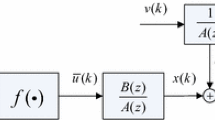Abstract
This paper deals with a non-parametric identification of continuous-time Hammerstein systems using Gaussian process (GP) models. A Hammerstein system consists of a memoryless non-linear static part followed by a linear dynamic part. The identification model is derived using the GP prior model which is described by the mean function vector and the covariance matrix. This prior model is trained by the separable least-squares (LS) approach combining the linear LS method with particle swarm optimization to minimize the negative log marginal likelihood of the identification data. Then the non-linear static part is estimated by the predictive mean function of the GP, and the confidence measure of the estimated non-linear static part is evaluated by the predictive covariance function of the GP. Simulation results are shown to illustrate the proposed method.






Similar content being viewed by others
References
Adachi S, Murakami H (1995) Generalized predictive control system design based on non-linear identification by using Hammerstein model (in Japanese). Trans ISCIE 8(3):115–121
Al-Duwaish H, Karim MN (1997) A new method for the identification of Hammerstein model. Automatica 33(10):1871–1875
Hatanaka T, Uosaki K, Koga M (2002) Evolutionary computation approach to Hammerstein model identification, In: Proceedings of the fourth Asian Control Conference, Singapore, Sep 25–27, 2002, pp 1730–1735
Hachino T, Takata H (2010) Identification of discrete-time Hammerstein systems using Gaussian process model. J Signal Process 14(2):129–137
O’Hagan A (1978) Curve fitting and optimal design for prediction (with discussion). J Roy Stat Soc B 40:1–42
Williams CKI, Rasmussen CE (1996) Gaussian processes for regression. In: Advances in Neural Information Processing Systems 8, MIT Press, Cambridge, Massachusetts, pp 514–520
Rasmussen CE, Williams CKI (2006) Gaussian processes for machine learning. MIT Press, Cambridge, Massachusetts
Kennedy J, Eberhart RC (1995) Particle swarm optimization. In: Proceedings of IEEE international conference on neural networks, Perth, Australia, Nov 27–Dec 1, 1995, pp 1942–1948
Yoshida H, Kawata K, Fukuyama Y et al (2000) A particle swarm optimization for reactive power and voltage control considering voltage security assessment. IEEE Trans Power Syst 15(4):1232–1239
Ide A, Yasuda K (2004) A basic study of the adaptive particle swarm optimization (in Japanese). IEEJ Trans EIS 124(2):550–557
Tsang KM, Billings SA (1994) Identification of continuous time nonlinear systems using delayed state variable filters. Int J Control 60(2):159–180
Kudo A, Kamimura H (1983) Statistical mathematics (in Japanese). Kyoritsu Shuppan, Tokyo
Mises R (1964) Mathematical theory of probability and statistics. Academic Press, New York
Hachino T, Nagatomo K, Takata H (2006) Identification of continuous-time Hammerstein systems using RBF networks and genetic algorithm. In: Proceedings of the 2006 RISP international workshop on nonlinear circuits and signal processing, Honolulu, Hawaii, USA, March 3–5, 2006, pp 21–24
Author information
Authors and Affiliations
Corresponding author
About this article
Cite this article
Hachino, T., Yamakawa, S. Non-parametric identification of continuous-time Hammerstein systems using Gaussian process model and particle swarm optimization. Artif Life Robotics 17, 35–40 (2012). https://doi.org/10.1007/s10015-012-0015-7
Received:
Accepted:
Published:
Issue Date:
DOI: https://doi.org/10.1007/s10015-012-0015-7




